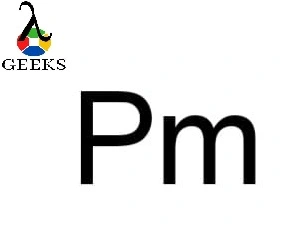Promethium is a rare element of the periodic table with radioactive isotopes. Let us discuss Promethium in this article.
Promethium has a double hexagonal close-packed crystalline structure. Its properties seem to be quite similar (intermediate) between the elements 60-62 (Neodymium – Samarium) of the periodic table. Sources of Promethium (natural) include alpha decay of Europium (151), yielding Promethium (147).
Promethium can also be prepared by the fission of various isotopes of Uranium. Let us discuss some properties like melting and boiling point, covalent radius, etc.
Promethium Symbol
The chemical element Promethium has the symbol Pm in the periodic table.

Promethium group in periodic table
Promethium is placed in the lanthanides (cerium) group of elements of periodic table. The elements belonging to lanthanides are quite reactive and show a high range of boiling and melting point.
Promethium period in periodic table
Promethium belongs to the period 6 of the periodic table of elements. Rows in the periodic table depict the periods.
Promethium block in periodic table
Promethium is situated in the f block of elements. These block elements are also known as inner transition metals. The division in a block is based on the valence electrons of the elements.
Promethium atomic number
The atomic number of the Promethium element is 61. Hence there are 61 protons in the Pm atom.
Promethium atomic weight
The atomic weight of the Promethium element is 145 g/mol. Atomic weight can be calculated by considering the ratio of mass (average) of the elements to a standard value.
Promethium Electronegativity according to Pauling
According to Pauling, the electronegativity of the Promethium element is 1.13. Electronegativity can be referred to as the possibility for an atom to lose or gain electrons in a covalent bonding.
Promethium atomic density
The atomic density of the Promethium element is 7.26 g/cm3 (room temperature). Calculation of atomic density can be carried out by division of mass by volume.
Promethium melting point
The melting point of the Promethium element is 1042°C. A substance that changes from one form to another (solid to liquid) is known as a melting point.
Promethium boiling point
The boiling point of Promethium element is 3000°C. A high boiling point is usually required when intermolecular attraction forces are quite strong.
Promethium Vanderwaals radius
The Van der Waals radius for the Promethium element is 290 pm.
Promethium covalent radius
The covalent radius for the element Promethium is 199 pm. When covalent bonding is taking place, the distance between the bonding atoms is known as the covalent radius.
Promethium isotopes
In an isotope, the number of neutrons changes, but the number of protons will remain the same. Let us study isotopes of Promethium.
To date, 38 isotopes of Promethium have been reported, and they are observed to be radioactive. But some of the stable isotopes are discussed below:
- 145Pm – The half-life of this isotope is 17.7 years. The molecular weight of this isotope is 144.9 g/mol.
- 146Pm – The half-life of this isotope is 5.53 years. The molecular weight of this isotope is 145.9 g/mol.
- 147Pm – The half-life of this isotope is 2.62 years. It finds application in nuclear batteries.
Promethium electronic shells
The shells around the nucleus having a particular number of electrons are known as electronic shells. Let us check for Promethium.
The number of electronic shells in the Promethium element is 6 having 2, 8, 18, 23, 8, and 2 electrons in each of the 6 shells, respectively.
Promethium energy of first ionisation
The first ionisation energy for the Promethium element is 540 kJ/mol. This is the energy required to take out the electron that is loosely bonded (outermost).
Promethium energy of second ionisation
The second ionisation energy for the Promethium element is 1050 kJ/mol. This is the energy required for taking out the second electron, which is loosely bonded, where one electron is already withdrawn.
Promethium energy of third ionisation
The third ionisation energy for the Promethium element is 2150 kJ/mol.
Promethium oxidation states
The observed oxidation states for the Promethium element are +2 and +3.
Promethium electron configuration
The electronic configuration for Promethium is [Xe] 4f5 6s2. The proper arrangement of electrons in atomic orbitals is depicted by an electronic configuration.
Promethium CAS number
The CAS number for Promethium is 7440-12-2. This is a unique 10-digit number used for identification purposes.
Promethium ChemSpider ID
The ChemSpider ID for the element Promethium is 22386. It helps in figuring out data from a list of vast data sources.
Promethium allotropic forms
An element can have various forms, and this property is termed an allotropic form. Let us check for the Promethium element.
Promethium element has 2 allotropic forms:
- Alpha phase – This isotope has a double close-packed hexagonal crystalline structure.
- Beta phase – This isotope has a body-centered cubic crystalline structure.
Promethium chemical classification
The chemical classification of Promethium:
- The radioactivity of the Promethium element is very high.
- Promethium element has 2 oxidation states, but +3 is the only state which is stable at all times.
- In appearance, the Promethium crystals are pink colored.
Promethium state at room temperature
The element Promethium is solid (at room temperature).
Is Promethium paramagnetic?
Materials that, when exposed to the magnetic field, are magnetized. Let us analyze for Promethium.
Promethium element is paramagnetic. The reason for this type of magnetic behavior is Promethium has unpaired electrons in the electronic configuration.
Conclusion
Promethium belongs to Lanthanide group of elements and is placed in f block of elements. Its isotopes are radioactive in nature.
This is Sania Jakati from Goa. I am an aspiring chemist pursuing my post graduation in organic chemistry. I believe education is the key element that moulds you into a great human being both mentally and physically. I’m glad to be a member of scintillating branch of chemistry and will try my best to contribute whatever I can from my side and Lambdageeks is the best platform where I can share as well as gain knowledge at the same time.